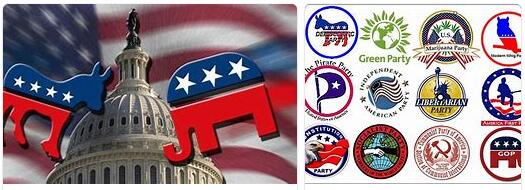The US two-party system has its origins in the opposition between federalists and antifederalists in the first years after independence, but only since the second half of the 19th century did American political life become polarized in the confrontation between Democrats and Republicans. which we know today. Over time, attempts to expand the system to a third party have not been lacking, but they have proved unsuccessful each time. The mechanism of presidential elections seems to have played a decisive role in the evolution towards bipartisanism, which requires the presence on such a vast territory of large organizations capable of concentrating and directing the choices of the voters.
In the American democratic system, the formation of parties was initially linked to the need to make the political organization of the opposition effective, ensuring the main mechanism on which the correct functioning of the system is based. As historian WE Binkley wrote, each of America’s major political parties “actually began as a party of anti-something.”
The first political party to organize itself on a national scale, following the launch of the new Constitution, was the Federalist Party, an advocate of a strong central government, an expression of the federal character of the Union. The Federalist Party remained in power from 1789 to 1801, when internal divisions and difficulties in organizing themselves in order to win the elections favored the affirmation of the opposition forces, which coalesced on the initiative of Thomas Jefferson and James Madison.
The new party, to emphasize its anti-monarchical inspiration, took the name of the Republican Democratic Party and its followers were also known as Jeffersonian Republicans. Organized starting from the 1890s, the Republican Democratic Party, direct antecedent of the current Democratic Party, was characterized by a critical attitude towards the aristocratic tendencies of the federalists and the economic policy of the first two presidencies, which had been addressed in favor of the higher classes.
After voicing three presidents (Jefferson, Madison and James Monroe), the Republican Democratic Party split, during the 1920s, into two sections: the current organized by Martin Van Buren, who, during the presidency of Andrew Jackson definitively adopted the name of the Democratic Party, and the followers of John Quincy Adams, who took the name of the National Republican Party. The Whig Party was born from this last formation, which coalesced with other groups united by dissent towards the policy of progressive expansion of democracy promoted by President Jackson., who was the main protagonist of the American political scene in the years 1834-54. The name was borrowed from the British political tradition – where the Whigs historically represented the opposition to the royal prerogative – to express the hostility towards the address aimed at strengthening the executive power that was pursued by Jackson, for this reason controversially nicknamed ‘King Andrew’.
Between Jackson’s departure (1837) and the outbreak of the Civil War (1861-65), the Democratic Party expressed four presidents (Van Buren, James Knox Polk, Franklin Pierce and James Buchanan), but on the issue of slavery it verified within it a split between northerners and southerners, which in the elections of 1861 favored the victory of the new Republican Party. Born in 1854 from the merger of groups united by the common rejection of slavery and the opposition to its extension into the new territories, the Republican Party, now known as the Grand Old Party, was originally characterized by the emphasis placed on the pre-eminence of the national interest over that of individual states and by the reference to the strongly unionist tradition of the old republicanism. Taking over the Whig Party in opposition to the Democrats, the Republicans, presenting themselves as defenders of the unity of the nation and interpreting the demands of the new expanding economy, dominated American political life for a long time starting in the decades following the end of the Civil War., often winning the presidency in competition with the Democrats and thus giving life to the political dialectic that still characterizes American electoral competitions.
The functioning of political parties is now largely legally regulated. The system of two parties alternating in power interferes in the administration of the state through what remains of the system of replacing officials whenever one party succeeds the other in power (spoils system). With this system largely abolished, electoral expenses have increased enormously, with elections at the local, state and confederal levels which are of such importance to American life and must be carefully organized, and with party conventions for choice. of presidential candidates. So the law had to intervene in order to guarantee all citizens the right to take part in the meetings for the nomination of candidates: all without distinction in the open primaries, all the members of their respective parties in the closed primaries. Thanks to this complex system, it is no longer possible for a small circle of party heads to control the entire electoral machine through the nomination of candidates.
